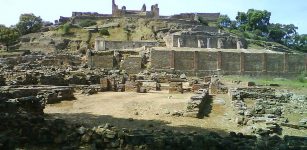Oldest Cyrillic Inscriptions Dated To The Time Of King Simeon the Great – Discovered
Conny Waters - AncientPages.com -Archaeologists have discovered one of the oldest Cyrillic inscriptions from the time of King Simeon the Great
This important discovery was made in the "Balak Dere" fortress near the Ivaylovgrad village of Huhla (Khuhla), Bulgaria, dated to the 10th century.
Image source
The team unearthed an ancient amulet (a lead plate), and this fascinating artifact is decorated with one of the oldest Cyrillic inscriptions, from the time of King Simeon the Great.
The text of the inscription is strictly canonical, according to the chief editor of the National History Museum (NIN) Ivaylo Kanev, who is studying the site.
The discovery was made at the end of the last archaeological season, however, conservation work required more time.
During conservation activities by Prof. Veselina Inkova, a shallow incised inscription with Cyrillic letters was noticed.” writes Rodopi-info.com
Now, all modern techniques are very helpful during the archaeological and conservation works.
Image source
In the course of the reading of this interesting and at the same time, oldest Cyrillic inscription, Dr. Georgi Sengalevich, used the so-called reflex-transformation (RTI) photography, and noticed that the beginning of the text was applied on the inner side of the plate.
The researchers carefully unfolded it and were happy to find a long Old Bulgarian Cyrillic inscription, seven lines on the inside and four lines on the outside of the plate.
This is perhaps one of the most significant finds of "Archaeological Summer" 22, researchers stated.
The discovery of the amulet plate is in a cultural layer, where there are many materials from the first half of the 10th century, writes the source.
This fact directs the attention of archaeologists to the era of the Golden Age of King Simeon (893-927).
Scientists began to compare the historical sources from the beginning of the 10th century, which describe the marches of the Bulgarian ruler to Constantinople, with the epigraphic analysis of the monument, where the archaic spelling of the letters Ж and a small handkerchief, found among the monuments from the 10th century, stand out.
Image source
The spelling is single-line , only with a large er (Б), which, according to them, brings the inscription in question closer to monuments mainly from North-Eastern Bulgaria.
In contrast to the previously known similar monuments, here the canonical sounding of the text and the reading of the personal names of the petitioners, namely Nicholas and Pavel, make a strong impression.
According to Archaeologia Bulgarica, "Balak Dere" is the name of locality near the village of Huhla near the city of Ivailovgrad in the Eastern Rhodope Mountains, over which the remains of a mysterious old fortress are overhanging.
Its ruins have been researched for years. The current team under the leadership of Ivaylo Kanev, chief curator of the National Museum of History, already has reliable evidence for the long "life" of the fortification: from IV to XII century inclusive.”
Written by Conny Waters - AncientPages.com Staff Writer























